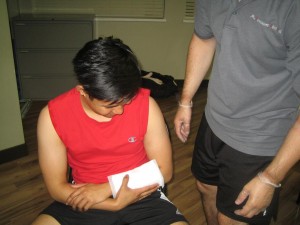Splinters can become contaminated it remains under the skin for too long. Search for signs of infection prior to removing any splinters.
- Skin turning red
- Inflammation
- Pus seeping from the wound
- Lots of pain even if there is no movement
If the splinter has become infected, visit a doctor so he can remove it. The odds of a splinter becoming contaminated depends on what the splinter is: raw material – like spines from an animal or thorns from a plant – are more likely to result in an infection or a poisonous reaction.
Here’s How:
- Clean your hands carefully before trying to get rid of the splinter.
- Before attempting more invasive approaches, press the skin from either side of the splinter to try and move the splinter back out the way it came.
- Take a clean needle and tweezers with povidone-iodine solution. Povidone-iodine is much more useful at killing germs than isopropyl alcohol.
- Clean the injury and area surrounding the splinter with soap and water. A tiny amount of povidone-iodine solution on the injury is also a great idea.
Splinters can become contaminated it remains under the skin for too long
- Take the needle and open the skin so there is enough space to grip the splinter with the tweezers and pull it out. Nail clippers can also be used if the tweezers don’t work – keep in mind too that you must clean the nail clippers with some povidone-iodine solution.
- Grab the end of the splinter and continue to move it back out the skin.
- Clean the injury with water and soap.
Tips:
- The pain caused by a splinter is more annoying than anything. Though, if the region is very tender, use a bee-sting swab to alleviate the pain.
- Splinters that are positioned beneath a fingernail might be very tricky. If the end of the splinter can’t be pulled with tweezers, either visit the doctor or wait for it to come out. A doctor can cut the nail away and remove the splinter. The other alternative is to keep the region spotless and wait until the nail grows which will then push the splinter out. Observe the region closely for signs of contamination or infection.
- Make certain the casualty is up to date with regards to tetanus inoculations. If not – have the doctor get rid of the splinter when going in to get the injection.
- Lastly, splinters will ultimately work out of the skin naturally and might not have to be removed by a doctor. You don’t need to hurry – wait until the correct hygiene can be achieved in order to get rid of any splinters.

